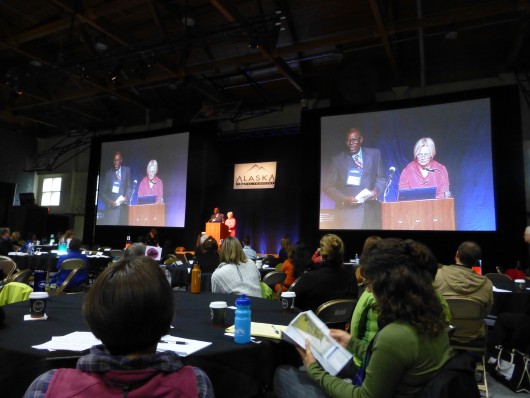
Lenwood Sloan, left on the screens, was keynote speaker at the Alaska Travel Industry Association conference. (Rich McClear/KCAW)
Lenwood Sloan calls himself a “Gunrunner for the arts.” He was a member of the Joffrey Ballet company until, he says, his body discovered gravity. He later became Pennsylvania’s film commissioner. In retirement he serves as a consultant linking the tourism industry with the arts. He was the keynote speaker at the recent Alaska Travel Industry Association Convention in Sitka.
The theme of the conference was “The Fine Art of tourism.” Links between tourism and the arts were a thread that wove throughout the entire meeting. But before he spoke he wanted everyone to experience the arts first hand, through singing “Amazing Grace.”
Sloan says people travel for many reasons. Only one is sightseeing. But sights don’t bring people back to a destination, experiences do. Visitors with good experiences become ambassadors. Arts are an important element in creating good experiences.
“Tourism benefits from the arts by infusing vitality into their destination product, by creating experience. We talked a lot about place. But once you get to the place, people are looking for the locals they’re looking for the experience, for the music, for the dance, for the jokes,” Sloan says. “Tourism creates the attraction of visitors to the destination. Culture provides the experience that they have once they get to the destination.”
“People come to places because of what places are,” says Roger Schmidt, director of the Sitka Fine Arts Camp.
“I think arts is one of the strongest expressions that people have of who they are and why they are. Any visitor that’s traveling is going to seek the most powerful experiences they can get access to and the arts can provide something that is extraordinary,” Schmidt says.
But arts organizations create more than experiences. Arts events become destinations in themselves. Schmidt says the Sitka Fine Arts Camp is a good example.
He points out that more than 700 students from 27 states and five countries attended the camp this year along with more than 100 faculty and staff, but that’s not all.
“We also had hundreds of parents that came and visited and when they come to see their kids perform or see their kids’ art show, not only do they come for that experience but they started thinking about well as long as we are in Sitka how can we extend our experience, what else can we do,” Schmidt says. “And so I think our program is bringing a lot of people to Sitka and they also go out and become our best ambassadors. They tell people Sitka is an amazing place.”
Schmidt does not know much people visiting for the fine arts camp spend on hotels, food and gifts but says that spending has to have a significant impact on the economy.
Sometimes communities don’t fully benefit from coordination between the arts and tourism because the two work on different timetables.
“Two weeks before the performance, they come to the tourism person and say ‘I have this play next week, why aren’t you promoting it?’ And the tourism person says, ‘Because I needed to know six months ago,’ ” Sloan says. “I tell a lot of artists, I call them up in June and say we’re making the 2014 calendar and travel guide, what are you doing? They go ‘I’m trying to get through my summer festival. I’ll tell you in September.’ And I say ‘September’s too late.’ ”
Sloan says arts organizations need to coordinate with tourism promoters a season in advance. And tour operators need to give arts organizations their promotion deadlines so that destinations can fully promote what is available in a community.































